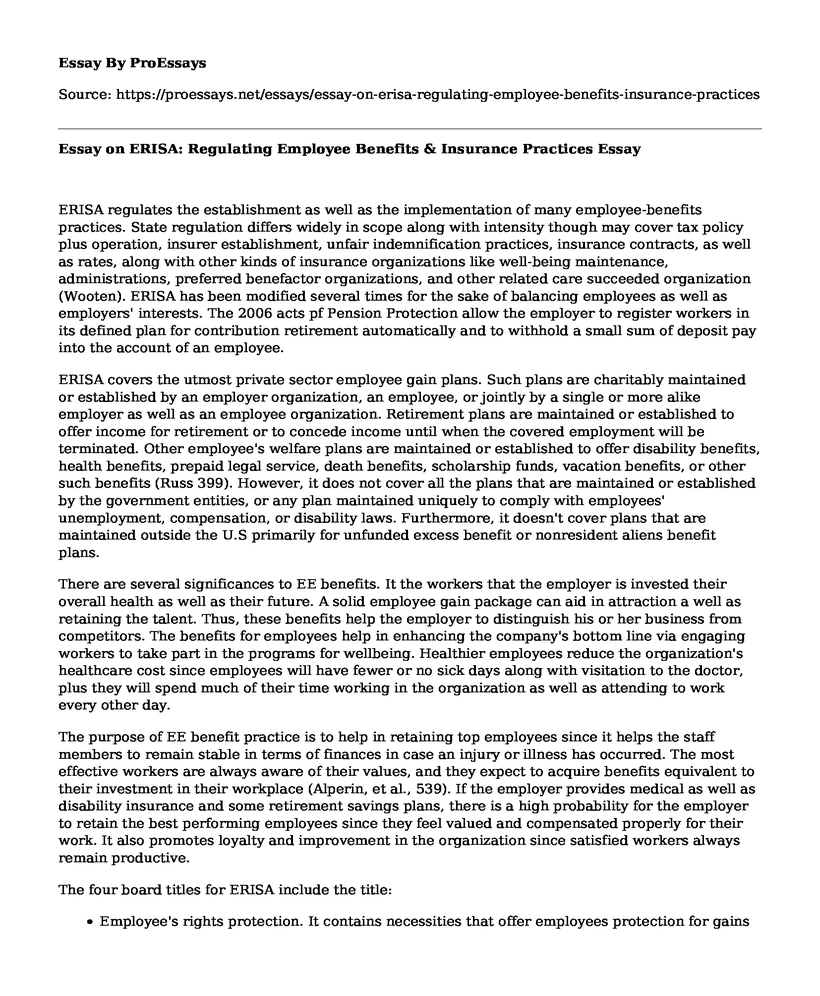ERISA regulates the establishment as well as the implementation of many employee-benefits practices. State regulation differs widely in scope along with intensity though may cover tax policy plus operation, insurer establishment, unfair indemnification practices, insurance contracts, as well as rates, along with other kinds of insurance organizations like well-being maintenance, administrations, preferred benefactor organizations, and other related care succeeded organization (Wooten). ERISA has been modified several times for the sake of balancing employees as well as employers' interests. The 2006 acts pf Pension Protection allow the employer to register workers in its defined plan for contribution retirement automatically and to withhold a small sum of deposit pay into the account of an employee.
ERISA covers the utmost private sector employee gain plans. Such plans are charitably maintained or established by an employer organization, an employee, or jointly by a single or more alike employer as well as an employee organization. Retirement plans are maintained or established to offer income for retirement or to concede income until when the covered employment will be terminated. Other employee's welfare plans are maintained or established to offer disability benefits, health benefits, prepaid legal service, death benefits, scholarship funds, vacation benefits, or other such benefits (Russ 399). However, it does not cover all the plans that are maintained or established by the government entities, or any plan maintained uniquely to comply with employees' unemployment, compensation, or disability laws. Furthermore, it doesn't cover plans that are maintained outside the U.S primarily for unfunded excess benefit or nonresident aliens benefit plans.
There are several significances to EE benefits. It the workers that the employer is invested their overall health as well as their future. A solid employee gain package can aid in attraction a well as retaining the talent. Thus, these benefits help the employer to distinguish his or her business from competitors. The benefits for employees help in enhancing the company's bottom line via engaging workers to take part in the programs for wellbeing. Healthier employees reduce the organization's healthcare cost since employees will have fewer or no sick days along with visitation to the doctor, plus they will spend much of their time working in the organization as well as attending to work every other day.
The purpose of EE benefit practice is to help in retaining top employees since it helps the staff members to remain stable in terms of finances in case an injury or illness has occurred. The most effective workers are always aware of their values, and they expect to acquire benefits equivalent to their investment in their workplace (Alperin, et al., 539). If the employer provides medical as well as disability insurance and some retirement savings plans, there is a high probability for the employer to retain the best performing employees since they feel valued and compensated properly for their work. It also promotes loyalty and improvement in the organization since satisfied workers always remain productive.
The four board titles for ERISA include the title:
- Employee's rights protection. It contains necessities that offer employees protection for gains rights such as subsidy, administrations and enforcement, reporting, and disclosure, among others.
- Internal income code provisions. Title II recompence the IRC connecting to pension tax treatment as well as welfare benefits plans. It provides an incentive for workers to establish the benefit plans for employees by giving favorable tax retirement.
- Jurisdiction, Enforcement, Administration, and other risks. This title grants the Department of Labor in U.S force for administering as well as enforcing title I reporting as well as disclosing fiduciary and requirements responsibilities.
- Plan and termination of insurance. The operations for this title are financed by coverage premiums that are set by Congress as well as paid for by investment income and defined benefit plans sponsors.
Penson plans offer a specified payment in retirement, while welfare plans allow employees along with the employers to contribute as well as invest money over a certain period to save for superannuation.
Works Cited
Alperin, Stuart N., et al. "The Employee Retirement Income Security Act of 1974: Policies and Problems." Syracuse L. Rev. 26 (1975): 539.
Russ, Emma L. "The Employee Retirement Income Security Act of 1974: An Outdated Regulatory Framework for Retirement Investors." Iowa L. Rev. 105 (2019): 399.
Wooten, James. The Employee Retirement Income Security Act of 1974: A Political History. Vol. 11. Univ of California Press, 2004.
Cite this page
Essay on ERISA: Regulating Employee Benefits & Insurance Practices. (2023, Apr 09). Retrieved from https://proessays.net/essays/essay-on-erisa-regulating-employee-benefits-insurance-practices
If you are the original author of this essay and no longer wish to have it published on the ProEssays website, please click below to request its removal:
- The Accounting Profession and Bankrate Case Paper Example
- Analysis of Wayne Farm Case Paper Example
- Application for Position of Customer Relations Advisor
- Essay Sample on DJ Technician: Employment & Labor Laws for the Entertainment Industry
- Essay Example on IES: 50 Years of Improving Work for Education, Government & More
- Essay Example on Embracing Cultural Diversity in Nursing: Exploring Transcultural Nursing
- Working with Nic: Professional & Ethical Considerations - Essay Sample







